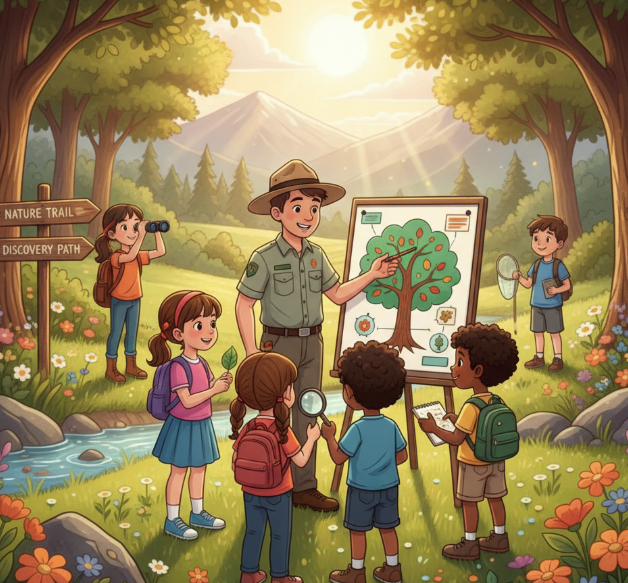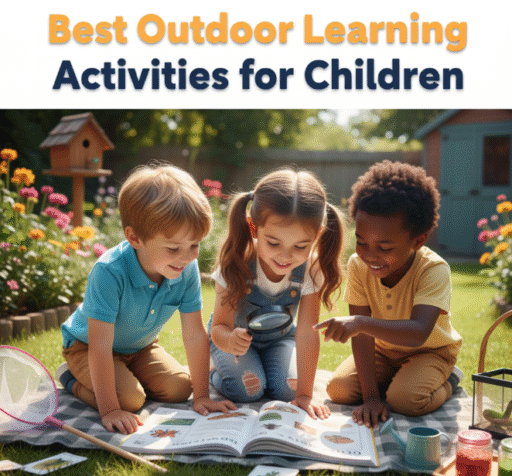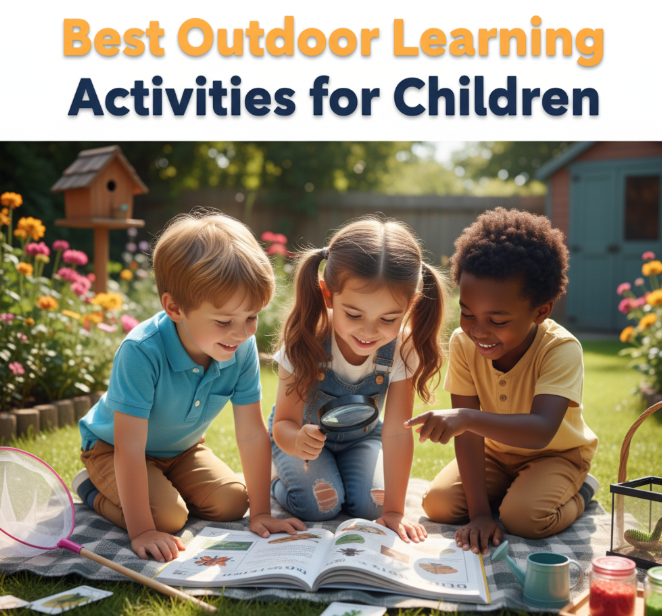Introduction: Why Outdoor Learning Matters
In today’s digital world, many children spend more time indoors with screens than outside exploring nature. Yet, research shows that outdoor learning activities provide countless benefits for children’s growth. Fresh air, sunlight, movement, and hands-on experiences help kids build stronger bodies, healthier minds, and sharper problem-solving skills.
Outdoor learning is not only about running around—it is about transforming the outdoors into a classroom. Whether it’s a school playground, a garden, a local park, or even the backyard, the natural environment offers endless opportunities for exploration and discovery.
This article will take you through some of the best outdoor learning activities for children, with practical tips, engaging ideas, and ways to make learning outside both fun and educational.
Benefits of Outdoor Learning for Kids
Before diving into the activities, let’s look at why outdoor learning is so powerful:
-
Boosts Physical Health – Running, climbing, and playing outdoors improve strength, flexibility, and coordination.
-
Encourages Curiosity and Discovery – Nature sparks questions and inspires children to investigate.
-
Improves Focus and Memory – Studies show that outdoor learning reduces stress and enhances concentration.
-
Builds Social Skills – Group activities outside teach teamwork, leadership, and cooperation.
-
Fosters Creativity – Open spaces and natural objects allow kids to create, imagine, and problem-solve freely.
Outdoor Learning Activities for Young Explorers
1. Nature Scavenger Hunt
A scavenger hunt is a timeless favorite that combines fun with discovery. Children can search for items like:
-
A smooth rock
-
A feather
-
Three different kinds of leaves
-
A stick shaped like the letter “Y”
How it helps:
-
Improves observation skills
-
Teaches kids about plants, animals, and natural objects
-
Encourages teamwork if played in groups
2. Outdoor Math Games
Math doesn’t have to be restricted to textbooks. Use the outdoors for hands-on problem-solving.
Examples:
-
Counting pinecones, stones, or flowers
-
Measuring the height of a tree using shadows
-
Creating geometric shapes with sticks
| Outdoor Math Activity | Skills Learned |
|---|---|
| Collecting 10 leaves of different sizes | Counting, sorting |
| Measuring the playground using footsteps | Estimation, measurement |
| Arranging rocks into triangles/squares | Geometry basics |
3. Gardening as a Learning Tool
Gardening teaches responsibility and patience while connecting children to the food cycle.
Activities include:
-
Planting seeds and tracking growth
-
Learning about soil, water, and sunlight
-
Composting food scraps
Key Lessons:
-
Science (photosynthesis, ecosystems)
-
Responsibility (daily watering, care)
-
Healthy eating habits
4. Storytelling Under the Sky
Take literacy outdoors by encouraging kids to create and share stories surrounded by nature.
Ideas:
-
Choose objects (leaf, stick, flower) and weave them into a story.
-
Tell “progressive stories” where each child adds a sentence.
-
Use chalk to write storylines on the pavement.
5. Nature Art and Crafts
Children can use natural objects to create beautiful, meaningful artwork.
Examples:
-
Leaf rubbings
-
Stone painting
-
Stick sculptures
This activity strengthens fine motor skills, creativity, and appreciation for natural beauty.
Outdoor Learning for Science and Discovery
6. Bug and Insect Observation
Give children magnifying glasses and let them observe ants, beetles, and butterflies.
-
Teach about habitats, food chains, and life cycles.
-
Compare different insects and record findings.
Pro Tip: Encourage respect for living things—no harming insects!
7. DIY Weather Station
Kids can learn about weather patterns by making simple tools:
-
A rain gauge (plastic bottle)
-
A wind vane (paper and straw)
-
A thermometer (basic store-bought one)
Tracking daily changes teaches data collection, graphing, and climate awareness.
8. Rock and Mineral Exploration
Children love collecting shiny stones. Take it further by teaching them about rock types:
-
Igneous (formed by volcanoes)
-
Sedimentary (layers over time)
-
Metamorphic (changed by pressure/heat)
This makes science tangible and exciting.
9. Shadow Experiments
With sunlight as the main tool, children can explore:
-
Measuring shadow lengths at different times of the day
-
Creating shadow art with hand shapes
-
Learning how Earth’s rotation causes shadows to move
10. Birdwatching Adventure
Provide binoculars and a guidebook. Ask children to:
-
Record bird species seen
-
Draw sketches of feathers and wings
-
Listen to bird calls and match them
Why it works: Teaches patience, observation, and environmental responsibility.
Outdoor Team Learning Activities
11. Obstacle Courses
Set up an outdoor course using ropes, cones, and natural elements.
Benefits:
-
Builds physical strength and agility
-
Encourages teamwork if children work in pairs
-
Improves problem-solving (finding fastest routes)
12. Group Science Experiments
Examples include:
-
Dropping water balloons from different heights to test gravity
-
Building a soda-bottle rocket
-
Creating a solar oven using cardboard and foil
These projects make STEM concepts exciting through hands-on experience.

13. Outdoor Drama and Roleplay
Children can act out plays or historical scenes outdoors.
Ideas:
-
Recreate a moment in history under the open sky
-
Roleplay as explorers, scientists, or adventurers
-
Write and perform mini-plays using nature as a stage
Outdoor Learning Games for Fun and Skill
14. Treasure Map Adventure
Create a map with clues and ask children to follow directions to find a “treasure” (stickers, healthy snacks, or toys).
Skills Developed:
-
Map reading
-
Logical thinking
-
Team coordination
15. Memory Game with Natural Objects
Place 10–15 natural items (pinecones, shells, leaves) on a blanket. Show them for 30 seconds, then cover them. Children recall as many as possible.
Boosts memory, focus, and attention to detail.
16. Outdoor Musical Games
Use sticks, stones, and buckets to create music. Play rhythm games like:
-
Copy the beat
-
Group drumming sessions
-
Musical storytelling
This enhances listening, coordination, and creativity.
Seasonal Outdoor Learning Ideas
Spring
-
Planting flowers and vegetables
-
Observing insects pollinating
-
Making spring journals
Summer
-
Water balloon science games
-
Sunprint art (using sunlight and paper)
-
Outdoor reading circles
Fall
-
Leaf collection and classification
-
Pumpkin experiments (floating, measuring, carving)
-
Nature walks with photo journals
Winter
-
Measuring snow depth
-
Building igloos or snow forts
-
Studying animal tracks in snow
Outdoor Learning Safety Tips for Parents and Teachers
-
Always check for safe spaces free of hazards.
-
Apply sunscreen and ensure proper hydration.
-
Use bug repellent when needed.
-
Teach kids respect for wildlife and plants.
-
Supervise group activities while allowing independence.
Quick Outdoor Activity Checklist
Here’s a ready-to-use checklist parents and teachers can follow:
| Category | Example Activities |
|---|---|
| Science Learning | Bug hunt, weather station, rock collection |
| Creative Arts | Nature crafts, storytelling, outdoor drama |
| Math & Literacy | Counting leaves, treasure maps, chalk games |
| Physical Growth | Obstacle courses, shadow races, group sports |
How Outdoor Learning Shapes the Future
Outdoor learning does more than keep kids busy—it builds lifelong habits. A child who grows vegetables may become more health-conscious. A student who observes birds might develop into a wildlife advocate. Outdoor classrooms create leaders, innovators, and problem-solvers by connecting real-life experiences to academic skills.
Conclusion: Turning Nature into the Best Classroom
The outdoors is not just a playground—it’s the greatest teacher of all. From scavenger hunts and gardening to birdwatching and science experiments, outdoor learning activities make education exciting, practical, and memorable.
Whether you’re a parent, teacher, or caregiver, the key is to encourage curiosity, creativity, and exploration. By letting children learn through nature, you give them tools not just for school—but for life.
So next time the sun is shining, skip the worksheets, step outside, and let the world itself teach your child something amazing.




